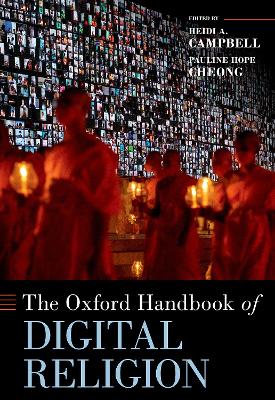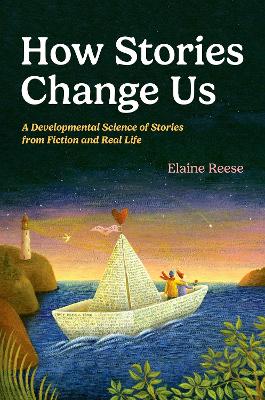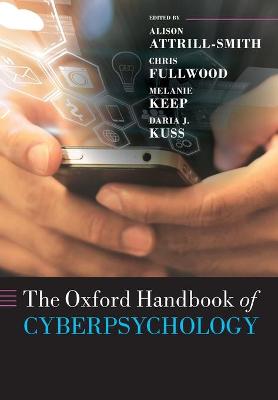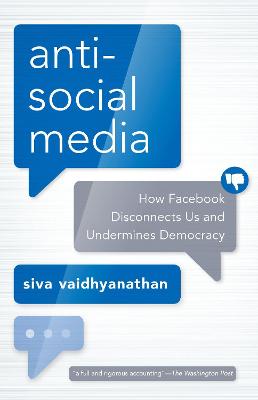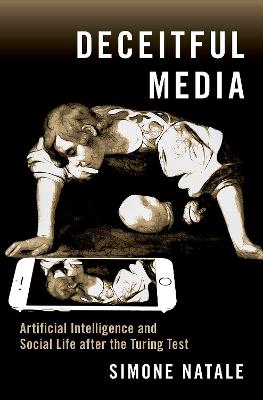Oxford Handbook of Cyberpsychology
 -10%
portes grátis
-10%
portes grátis
Oxford Handbook of Cyberpsychology
Kuss, Daria J.; Attrill-Smith, Alison; Keep, Melanie; Fullwood, Chris
Oxford University Press
05/2019
784
Dura
Inglês
9780198812746
15 a 20 dias
1508
Descrição não disponível.
Part I: Introduction and foundations
1: John Krantz: Cyberpsychology research methods
2: Alison Attrill-Smith: The Online Self
3: Yair Amichai-Hamburger: Personality and Internet use: The case of introversion and extroversion
4: Chris Fullwood: Impression management and self-presentation online
Part II: Technology across the lifespan
5: Cody Devyn Weeks and Kaveri Subrahmanyam: Adolescent and Emerging Adult Perception and Participation in Problematic and Risky Online Behavior
6: Linda Corrin, Tiffani Apps, Karley Beckman, and Sue Bennett: The myth of the digital native and what it means for higher education
7: Michelle Drouin and Brandon T McDaniel: Technology interference in couple and family relationships
8: Meryl Lovarini, Kate O'Loughlin, and Lindy Clemson: Older Adults and Digital Technologies
Part III: Interaction and interactivity
9: Nenagh Kemp: Textese: Language in the online world
10: Heyla Selim: Cultural considerations on online interactions
11: Joanne Lloyd, Alison Attrill-Smith, and Chris Fullwood: Online Romantic Relationships
12: Jenna L. Clark and Melanie C. Green: The Social Consequences of Online Interaction
Part IV: Groups and communities
13: Neil S. Coulson: Online Support Communities
14: Darren Chadwick, Melanie Chapman and Sue Caton: Digital Inclusion for People with an Intellectual Disability
15: Ma%sa Popovac and Chris Fullwood: The Psychology of Online Lurking
16: Bei Yan, Young Ji Kim, Andrea B. Hollingshead, and David P. Brandon: Conceptualizing Online Groups as Multidimensional Networks
Part V: Social media
17: Lisa J. Orchard: Uses and Gratifications and Social Media: Who uses it and why?
18: Melanie Keep, Anna Janssen, Dr Krestina Amon: Image Sharing on Social Networking Sites: Who, what, why, and so what?
19: Chris Stiff: Social Media and Cyberactivism
20: Bradley M. Okdie and Daniel M. Rempala: Socially connecting through blogs and vlogs: A social connections approach to blogging and vlogging motivation
21: Sally Quinn: Positive aspects of social media
Part VI: Health and technology
22: Elizabeth Sillence and Pam Briggs: Managing your Health Online: Issues in the selection, curation, and sharing of digital health information
23: Daria Kuss, Halley Pontes, Orsi Kiraly, and Zsolt Demetrovics: A psychological overview of gaming disorder
24: Elaine Kasket: Mourning and Memorialisation on Social Media
25: Mark Griffiths: The Therapeutic and Health Benefits of Playing Videogames
Part VII: Gaming
26: Jessica McCain, Kyle Morrison, and Sun Joo (Grace) Ahn: Video Games and Behavior Change
27: Angelica Ortiz de Gortari: Gaming transfer phenomena
28: Michelle Colder Carras, Rachel Kowert, and Thorsten Quandt: Psychosocial effects of gaming
29: Garry Young: Enacting immorality within gamespace: Where should we draw the line and why?
30: Linda Kaye: Gaming classifications and player demographics
Part VIII: Cybercrime and cybersecurity
31: Grainne H. Kirwan: The rise of cybercrime
32: Tom Holt and Jin Ree Lee: Policing Cybercrime through Law Enforcement and Industry Mechanisms
33: Jason RC Nurse: Cybercrime and You: How criminals attack and the human factors that make attacks successful
34: Jason RC Nurse and Maria Bada: The Group Element of Cybercrime: Types, dynamics, and criminal operations
1: John Krantz: Cyberpsychology research methods
2: Alison Attrill-Smith: The Online Self
3: Yair Amichai-Hamburger: Personality and Internet use: The case of introversion and extroversion
4: Chris Fullwood: Impression management and self-presentation online
Part II: Technology across the lifespan
5: Cody Devyn Weeks and Kaveri Subrahmanyam: Adolescent and Emerging Adult Perception and Participation in Problematic and Risky Online Behavior
6: Linda Corrin, Tiffani Apps, Karley Beckman, and Sue Bennett: The myth of the digital native and what it means for higher education
7: Michelle Drouin and Brandon T McDaniel: Technology interference in couple and family relationships
8: Meryl Lovarini, Kate O'Loughlin, and Lindy Clemson: Older Adults and Digital Technologies
Part III: Interaction and interactivity
9: Nenagh Kemp: Textese: Language in the online world
10: Heyla Selim: Cultural considerations on online interactions
11: Joanne Lloyd, Alison Attrill-Smith, and Chris Fullwood: Online Romantic Relationships
12: Jenna L. Clark and Melanie C. Green: The Social Consequences of Online Interaction
Part IV: Groups and communities
13: Neil S. Coulson: Online Support Communities
14: Darren Chadwick, Melanie Chapman and Sue Caton: Digital Inclusion for People with an Intellectual Disability
15: Ma%sa Popovac and Chris Fullwood: The Psychology of Online Lurking
16: Bei Yan, Young Ji Kim, Andrea B. Hollingshead, and David P. Brandon: Conceptualizing Online Groups as Multidimensional Networks
Part V: Social media
17: Lisa J. Orchard: Uses and Gratifications and Social Media: Who uses it and why?
18: Melanie Keep, Anna Janssen, Dr Krestina Amon: Image Sharing on Social Networking Sites: Who, what, why, and so what?
19: Chris Stiff: Social Media and Cyberactivism
20: Bradley M. Okdie and Daniel M. Rempala: Socially connecting through blogs and vlogs: A social connections approach to blogging and vlogging motivation
21: Sally Quinn: Positive aspects of social media
Part VI: Health and technology
22: Elizabeth Sillence and Pam Briggs: Managing your Health Online: Issues in the selection, curation, and sharing of digital health information
23: Daria Kuss, Halley Pontes, Orsi Kiraly, and Zsolt Demetrovics: A psychological overview of gaming disorder
24: Elaine Kasket: Mourning and Memorialisation on Social Media
25: Mark Griffiths: The Therapeutic and Health Benefits of Playing Videogames
Part VII: Gaming
26: Jessica McCain, Kyle Morrison, and Sun Joo (Grace) Ahn: Video Games and Behavior Change
27: Angelica Ortiz de Gortari: Gaming transfer phenomena
28: Michelle Colder Carras, Rachel Kowert, and Thorsten Quandt: Psychosocial effects of gaming
29: Garry Young: Enacting immorality within gamespace: Where should we draw the line and why?
30: Linda Kaye: Gaming classifications and player demographics
Part VIII: Cybercrime and cybersecurity
31: Grainne H. Kirwan: The rise of cybercrime
32: Tom Holt and Jin Ree Lee: Policing Cybercrime through Law Enforcement and Industry Mechanisms
33: Jason RC Nurse: Cybercrime and You: How criminals attack and the human factors that make attacks successful
34: Jason RC Nurse and Maria Bada: The Group Element of Cybercrime: Types, dynamics, and criminal operations
Este título pertence ao(s) assunto(s) indicados(s). Para ver outros títulos clique no assunto desejado.
- Interacção homem-computador
- Estudos de comunicação
- Guias de Internet e serviços on-line
- Media, informação e indústrias das comunicações
- Aspectos éticos e sociais da Tecnologia Informática
- Impacto da ciência e da tecnologia na sociedade
- O eu, ego, identidade, personalidade
- Psicologia social, de grupo ou colectiva
- Comunicação e apresentação do negócio
Part I: Introduction and foundations
1: John Krantz: Cyberpsychology research methods
2: Alison Attrill-Smith: The Online Self
3: Yair Amichai-Hamburger: Personality and Internet use: The case of introversion and extroversion
4: Chris Fullwood: Impression management and self-presentation online
Part II: Technology across the lifespan
5: Cody Devyn Weeks and Kaveri Subrahmanyam: Adolescent and Emerging Adult Perception and Participation in Problematic and Risky Online Behavior
6: Linda Corrin, Tiffani Apps, Karley Beckman, and Sue Bennett: The myth of the digital native and what it means for higher education
7: Michelle Drouin and Brandon T McDaniel: Technology interference in couple and family relationships
8: Meryl Lovarini, Kate O'Loughlin, and Lindy Clemson: Older Adults and Digital Technologies
Part III: Interaction and interactivity
9: Nenagh Kemp: Textese: Language in the online world
10: Heyla Selim: Cultural considerations on online interactions
11: Joanne Lloyd, Alison Attrill-Smith, and Chris Fullwood: Online Romantic Relationships
12: Jenna L. Clark and Melanie C. Green: The Social Consequences of Online Interaction
Part IV: Groups and communities
13: Neil S. Coulson: Online Support Communities
14: Darren Chadwick, Melanie Chapman and Sue Caton: Digital Inclusion for People with an Intellectual Disability
15: Ma%sa Popovac and Chris Fullwood: The Psychology of Online Lurking
16: Bei Yan, Young Ji Kim, Andrea B. Hollingshead, and David P. Brandon: Conceptualizing Online Groups as Multidimensional Networks
Part V: Social media
17: Lisa J. Orchard: Uses and Gratifications and Social Media: Who uses it and why?
18: Melanie Keep, Anna Janssen, Dr Krestina Amon: Image Sharing on Social Networking Sites: Who, what, why, and so what?
19: Chris Stiff: Social Media and Cyberactivism
20: Bradley M. Okdie and Daniel M. Rempala: Socially connecting through blogs and vlogs: A social connections approach to blogging and vlogging motivation
21: Sally Quinn: Positive aspects of social media
Part VI: Health and technology
22: Elizabeth Sillence and Pam Briggs: Managing your Health Online: Issues in the selection, curation, and sharing of digital health information
23: Daria Kuss, Halley Pontes, Orsi Kiraly, and Zsolt Demetrovics: A psychological overview of gaming disorder
24: Elaine Kasket: Mourning and Memorialisation on Social Media
25: Mark Griffiths: The Therapeutic and Health Benefits of Playing Videogames
Part VII: Gaming
26: Jessica McCain, Kyle Morrison, and Sun Joo (Grace) Ahn: Video Games and Behavior Change
27: Angelica Ortiz de Gortari: Gaming transfer phenomena
28: Michelle Colder Carras, Rachel Kowert, and Thorsten Quandt: Psychosocial effects of gaming
29: Garry Young: Enacting immorality within gamespace: Where should we draw the line and why?
30: Linda Kaye: Gaming classifications and player demographics
Part VIII: Cybercrime and cybersecurity
31: Grainne H. Kirwan: The rise of cybercrime
32: Tom Holt and Jin Ree Lee: Policing Cybercrime through Law Enforcement and Industry Mechanisms
33: Jason RC Nurse: Cybercrime and You: How criminals attack and the human factors that make attacks successful
34: Jason RC Nurse and Maria Bada: The Group Element of Cybercrime: Types, dynamics, and criminal operations
1: John Krantz: Cyberpsychology research methods
2: Alison Attrill-Smith: The Online Self
3: Yair Amichai-Hamburger: Personality and Internet use: The case of introversion and extroversion
4: Chris Fullwood: Impression management and self-presentation online
Part II: Technology across the lifespan
5: Cody Devyn Weeks and Kaveri Subrahmanyam: Adolescent and Emerging Adult Perception and Participation in Problematic and Risky Online Behavior
6: Linda Corrin, Tiffani Apps, Karley Beckman, and Sue Bennett: The myth of the digital native and what it means for higher education
7: Michelle Drouin and Brandon T McDaniel: Technology interference in couple and family relationships
8: Meryl Lovarini, Kate O'Loughlin, and Lindy Clemson: Older Adults and Digital Technologies
Part III: Interaction and interactivity
9: Nenagh Kemp: Textese: Language in the online world
10: Heyla Selim: Cultural considerations on online interactions
11: Joanne Lloyd, Alison Attrill-Smith, and Chris Fullwood: Online Romantic Relationships
12: Jenna L. Clark and Melanie C. Green: The Social Consequences of Online Interaction
Part IV: Groups and communities
13: Neil S. Coulson: Online Support Communities
14: Darren Chadwick, Melanie Chapman and Sue Caton: Digital Inclusion for People with an Intellectual Disability
15: Ma%sa Popovac and Chris Fullwood: The Psychology of Online Lurking
16: Bei Yan, Young Ji Kim, Andrea B. Hollingshead, and David P. Brandon: Conceptualizing Online Groups as Multidimensional Networks
Part V: Social media
17: Lisa J. Orchard: Uses and Gratifications and Social Media: Who uses it and why?
18: Melanie Keep, Anna Janssen, Dr Krestina Amon: Image Sharing on Social Networking Sites: Who, what, why, and so what?
19: Chris Stiff: Social Media and Cyberactivism
20: Bradley M. Okdie and Daniel M. Rempala: Socially connecting through blogs and vlogs: A social connections approach to blogging and vlogging motivation
21: Sally Quinn: Positive aspects of social media
Part VI: Health and technology
22: Elizabeth Sillence and Pam Briggs: Managing your Health Online: Issues in the selection, curation, and sharing of digital health information
23: Daria Kuss, Halley Pontes, Orsi Kiraly, and Zsolt Demetrovics: A psychological overview of gaming disorder
24: Elaine Kasket: Mourning and Memorialisation on Social Media
25: Mark Griffiths: The Therapeutic and Health Benefits of Playing Videogames
Part VII: Gaming
26: Jessica McCain, Kyle Morrison, and Sun Joo (Grace) Ahn: Video Games and Behavior Change
27: Angelica Ortiz de Gortari: Gaming transfer phenomena
28: Michelle Colder Carras, Rachel Kowert, and Thorsten Quandt: Psychosocial effects of gaming
29: Garry Young: Enacting immorality within gamespace: Where should we draw the line and why?
30: Linda Kaye: Gaming classifications and player demographics
Part VIII: Cybercrime and cybersecurity
31: Grainne H. Kirwan: The rise of cybercrime
32: Tom Holt and Jin Ree Lee: Policing Cybercrime through Law Enforcement and Industry Mechanisms
33: Jason RC Nurse: Cybercrime and You: How criminals attack and the human factors that make attacks successful
34: Jason RC Nurse and Maria Bada: The Group Element of Cybercrime: Types, dynamics, and criminal operations
Este título pertence ao(s) assunto(s) indicados(s). Para ver outros títulos clique no assunto desejado.
- Interacção homem-computador
- Estudos de comunicação
- Guias de Internet e serviços on-line
- Media, informação e indústrias das comunicações
- Aspectos éticos e sociais da Tecnologia Informática
- Impacto da ciência e da tecnologia na sociedade
- O eu, ego, identidade, personalidade
- Psicologia social, de grupo ou colectiva
- Comunicação e apresentação do negócio


